Diamond Cutting Companies: Insights into the Industry
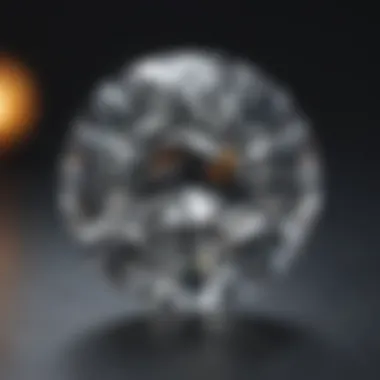
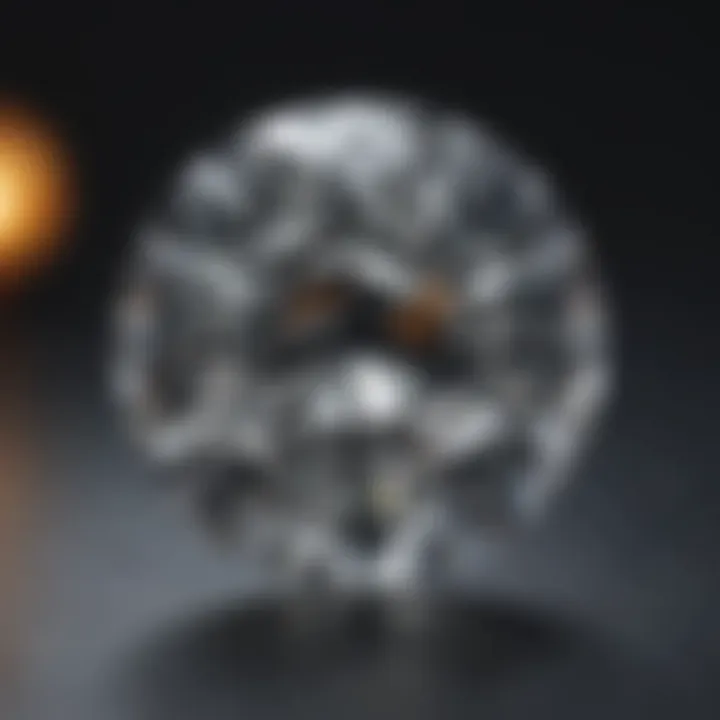
Intro
The diamond cutting industry plays a crucial role in determining the brilliance and character of gemstones. Understanding this sector requires a grasp of its techniques, artistry, and the broader implications within the gem market. The process of transforming rough diamonds into dazzling jewels is not just about cutting but also involves a confluence of tradition, technology, and ethical considerations. In this exploration, we will delve into various facets of diamond cutting companies, examining the skills required, the type of cutting methods they employ, and how they navigate the complexities of the global diamond landscape.
Gemstone Overview
Definition and Origins
Diamonds, classified as a form of carbon, are renowned for their remarkable hardness and light-reflecting properties. The origins of diamonds trace back millions of years, formed deep within the Earth under conditions of extreme pressure and temperature. They are found in natural deposits largely located in regions like South Africa, Russia, and Canada. The formation process is fascinating, leading to gemstones that capture human interest both aesthetically and economically.
Historical Significance
The historical significance of diamonds extends far beyond their physical beauty. In ancient civilizations, diamonds were believed to possess protective properties and were often associated with wealth and power. They were used as talismans in battles and as symbols of devotion in marital customs. Over time, diamonds evolved from being unique relics of nature to being sought after globally for their role in jewelry and investment. The diamond cutting industry, which emerged as specialized craftsmanship, continues to drive their desirability.
Gemstone Properties
Hardness and Durability
Diamonds are famous for being the hardest natural substance known to man, rated a ten on the Mohs scale. This exceptional hardness gives them an unrivaled durability that makes them suitable for everyday wear. Unlike many other gemstones, which may chip or scratch easily, diamonds withstand significant wear, maintaining their clarity and brilliance over time.
Color and Clarity
In terms of color, diamonds are often categorized into colorless, tinted, or colored stones. The GIA grading scale evaluates diamonds on a scale from D (colorless) to Z (light yellow). Clarity, on the other hand, refers to the presence of inclusions and blemishes. A diamond with fewer imperfections will have a higher value. Understanding these properties is vital for both consumers and professionals in the jewelry industry.
"Diamonds are more than just stones; they are the embodiment of human aspiration and craftsmanship."
As we continue through this article, we will analyze various cutting techniques, explore the craftsmanship involved, and reflect on the industry’s ethical considerations. The diamond cutting companies’ influence over market standards and quality assurance will also become apparent, revealing the essential role they play in the diamond trade.
Overview of Diamond Cutting
Diamond cutting is a crucial process in transforming raw gemstones into exquisite pieces suitable for adornment and investment. This overview serves to emphasize the multifaceted aspects of diamond cutting and its significance within the gem industry.
A well-executed diamond cut can enhance the stone's brilliance and overall aesthetic appeal. Precision in cutting affects light performance, which in turn influences the gem's allure. This makes it essential for diamond cutting companies to harness the right techniques and skill set.
History of Diamond Cutting
The history of diamond cutting dates back several centuries. Diamonds have been admired for their rarity and beauty since ancient times. Initially, diamonds were used in their natural form, often unpolished. The first known method of diamond cutting emerged in the late 15th century with the creation of the point cut, marking a shift towards more refined practices.
As techniques evolved, the table cut and later the brilliant cut emerged. These cuts allowed for better light reflection and refraction, significantly enhancing the gem’s sparkle. The development of the modern brilliant cut in the 20th century was pivotal, as this cut became the standard for many engagement rings and high-end jewelry.
Understanding the history of diamond cutting helps appreciate today’s sophisticated methods. Techniques from the past laid the groundwork for innovative practices, shaping the craftsmanship we see today.
Significance in the Gem Industry
The significance of diamond cutting within the gem industry cannot be overstated. It acts as a bridge between the raw diamond and the end product that consumers desire. This transformation is vital not only for aesthetic value but also for economic factors.
- Quality of Investment: A well-cut diamond retains its value better compared to poorly cut stones.
- Market Demand: Consumers often prefer diamonds that exhibit superior cutting, leading to higher demand for expertly crafted stones.
- Bridal Jewelry Influence: The popularity of diamond engagement rings has elevated the importance of diamond cutting in both contemporary culture and commerce.
"The cut of a diamond is its most important feature, affecting both beauty and value."
Types of Diamond Cuts
The types of diamond cuts are paramount in the diamond cutting industry. Each cut reflects aesthetic preferences and has a distinct method in its execution. Cuts not only enhance the diamond's brilliance and light performance but also influence its value. Consumers often determine their choice of diamond based on its cut, which impacts how the stone interacts with light and appears visually. Thus, understanding these cuts is essential for enthusiasts, collectors, and jewelry designers alike.
Brilliant Cut
The Brilliant Cut is recognized as one of the most popular diamond shapes. This cut features a round shape and is designed to maximize light reflection. The cut has numerous facets, typically 58, that create a sparkling effect. Each facet is carefully angled to catch light, contributing to the diamond's brilliance. Gemologists prefer this cut for its ability to showcase the diamond's color and clarity.
When evaluating a Brilliant Cut, factors such as symmetry and polish quality are significant. The better these aspects are, the greater the diamond's performance in terms of light reflection. Many consumers choose this cut for engagement rings due to its classic appeal and versatility.
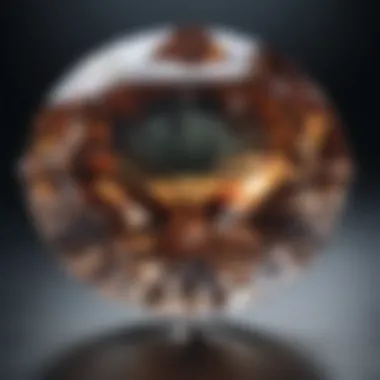
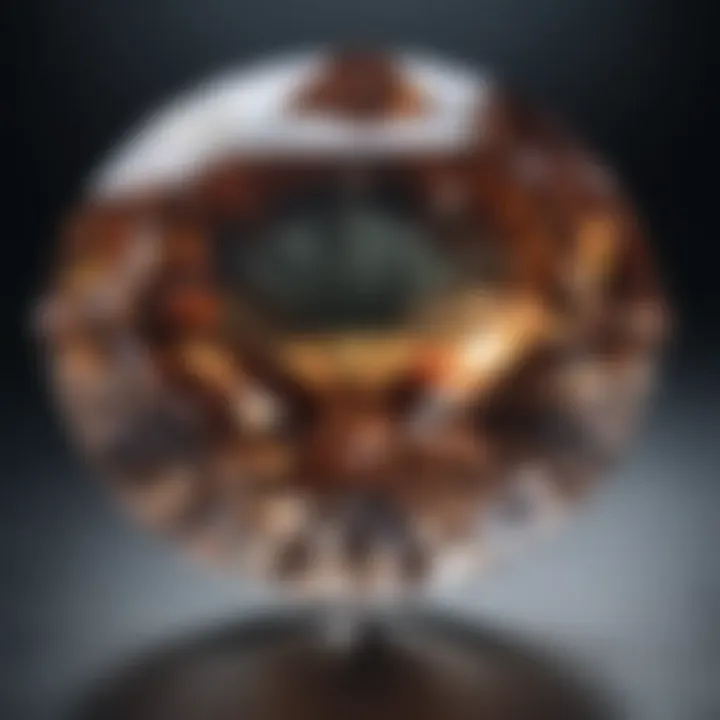
Emerald Cut
The Emerald Cut stands apart because of its step-like appearance and elongated shape. Unlike the Brilliant Cut, it has fewer facets, which allows for a more subdued shine. This cut highlights the diamond’s clarity rather than its sparkle. The rectangular shape often makes inclusions more visible, demanding higher quality rough diamonds for optimal results.
Collectors appreciate this cut for its elegant aesthetic and the vintage style it often portrays. Its unique design has become a favorite among those looking for sophistication in their jewelry. The Emerald Cut is particularly popular for creating stunning rings and pendants.
Princess Cut
The Princess Cut is a contemporary cut that has gained popularity since the late 20th century. This square or rectangular shape offers a modern approach while retaining the brilliance associated with the Brilliant Cut. It contains numerous facets and is often chosen for its edgy appearance. Consumers are drawn to this cut due to its versatility; it suits various jewelry designs, from engagement rings to earrings.
The Princess Cut, when done correctly, provides great sparkle and hides inclusions well, making it a highly sought-after choice. Its adaptability also allows it to be combined with other cuts in jewelry settings, enhancing the overall design.
Other Notable Cuts
Aside from the Brilliant, Emerald, and Princess cuts, several other shapes hold significance in the diamond market.
- Asscher Cut: This is a square cut similar to the Emerald, with a vintage appeal and impressive clarity focus.
- Cushion Cut: This cut features rounded corners and larger facets, giving it a romantic and vintage flair.
- Oval Cut: An elongated version of the round cut, it offers uniqueness while retaining the shine of traditional cuts.
- Marquise Cut: This cut features pointed ends and is designed to appear larger than its carat weight.
Each of these cuts is chosen based on personal taste and practicality. As the market grows, new trends continue to emerge, influencing consumer choices to create stunning and unique diamond jewelry.
The Diamond Cutting Process
The diamond cutting process is central to the diamond industry. It shapes rough diamonds into stunning gemstones, significantly affecting their value and appeal. This process involves several meticulous steps, each requiring specific skills and knowledge. The result is not just a beautiful diamond but also a reflection of the craftsmanship and technology that goes into creating each piece. Understanding this intricate process helps in appreciating the artistry behind diamond cutting and its importance in the gem industry.
Sourcing Rough Diamonds
Sourcing rough diamonds is the first step in the diamond cutting process. It involves obtaining uncut stones from various suppliers. These suppliers can range from large mining companies like De Beers to small independent miners. The quality of the rough diamond has a direct impact on the final product. Factors such as clarity, color, and carat weight must be considered.
Many diamond cutting companies establish strong relationships with suppliers to secure high-quality rough diamonds. This sourcing process often includes checking the provenance of the diamonds, ensuring they are conflict-free. The ethics surrounding this sourcing are significant; customers are increasingly concerned about the origins of their gemstones.
"Ethical sourcing is no longer an option; it is an expectation in the modern diamond market."
Cutting Techniques
Cutting techniques vary widely and play a critical role in determining the final appearance of the diamond. The primary goal during this stage is to maximize brilliance and fire. Common techniques include laser cutting and bruting, a method where diamonds are shaped by being rubbed against each other.
Laser cutting has transformed the industry, allowing for precision that was not possible before. Today, most skilled cutters use a combination of traditional techniques and advanced technologies. Each cut has its unique characteristics:
- Brilliant Cut: Maximizes sparkle and brilliance.
- Emerald Cut: Features a step-cut style that emphasizes clarity.
- Princess Cut: Combines modern appeal with traditional facets.
Understanding these cutting techniques helps consumers appreciate the value and beauty in their diamonds.
Polishing and Finishing
Polishing and finishing are the final steps in the diamond cutting process. After the diamond has been cut, it undergoes polishing to enhance its shine and clarity. This step can significantly affect the diamond’s final appearance. Various tools, including polishing wheels and compounds, are used to achieve the desired finish.
Finishing also includes inspecting the diamond for any imperfections. High-quality diamonds submit to rigorous quality control processes to ensure they meet industry standards. A well-polished diamond will reflect light beautifully, showcasing the skill of the cutter.
In summary, the diamond cutting process is a blend of art and science, requiring significant skill and ethical practices. Each step—from sourcing rough diamonds to polishing the final product—plays a vital role in how diamonds are perceived in the market.
Skills and Expertise Required
The diamond cutting industry demands a high level of expertise and skill. These competencies are essential not only for the aesthetic quality of the finished product but also for the overall economic viability of a diamond cutting business. Mastering these skills enhances the value of a diamond, ensuring that consumers receive a product worth their investment.
Gemological Knowledge
Gemological knowledge is foundational for anyone in the diamond cutting industry. This includes understanding different types of diamonds, their origin, and their characteristics. Gemologists must be familiar with the Four Cs: cut, color, clarity, and carat weight. This knowledge guides cutters in making decisions that maximize a stone's value. It allows them to assess quality and make informed choices about how to cut each diamond to enhance its unique features.
Furthermore, gemologists keep abreast of market trends and ethical sourcing practices. This information can significantly affect a diamond's desirability and price. For those involved in the diamond cutting process, staying knowledgeable about gemstone properties is a continuous requirement.
Precision and Attention to Detail
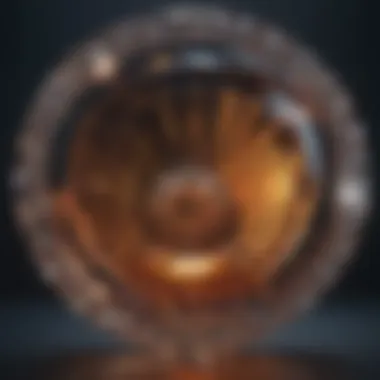

Precision and attention to detail are paramount in diamond cutting. Even the smallest miscalculation can lead to a significant devaluation of the stone. Cutting diamonds is a meticulous process that requires exact measurements and flawless execution. The cutter needs to understand how to shape the diamond to reflect light optimally. This intricate work is often performed using specialized machinery and tools.
The equisite craftsmanship not only impacts the diamond’s visual appeal but also influences its structural integrity. A well-cut diamond retains its sturdiness, reducing the chance for breakage during handling or setting. Each cut must be carefully planned and executed with precision, demonstrating the critical nature of skill in this field.
Artistic Sensibility
Artistic sensibility plays a vital role in diamond cutting. A cutter must have an innate understanding of beauty and aesthetics, translating technical knowledge into a visually appealing final product. This involves a keen sense of proportion and the ability to envision how a rough stone will ultimately look once it is shaped and polished.
An impactful design can elevate a diamond’s desirability in the market. Cutters might adapt their techniques to align with current trends or customer preferences. Therefore, the combination of artistic vision and technical skill within the field can lead to the creation of remarkable designs that capture the consumer’s interest.
Craftsmanship in diamond cutting is not solely about precision; it's also about artistry, marrying technical expertise with creative expression.
Technological Advancements in Diamond Cutting
The diamond cutting industry has benefited significantly from technological advancements over recent years. These innovations have transformed traditional practices, bolstered precision, and enhanced efficiency. It is crucial to recognize how technology shapes every aspect of diamond cutting, from the initial stages of cutting to the finishing touches.
Laser Cutting Technology
Laser cutting is one of the most impactful advancements in the industry. Previously, diamond cutters relied on tools like diamond blades and saws, which could be time-consuming and prone to human error. Laser technology offers a more precise and efficient method for cutting rough diamonds into desired shapes.
The use of lasers allows for intricate designs that were once challenging to achieve. The focused beam of light can create clean, accurate cuts, minimizing waste and maximizing the quality of the final product. Additionally, the ability to program specific cut parameters enhances consistency, critical in an industry where uniformity can significantly affect pricing and marketability.
One notable feature of laser cutting is its versatility. Each diamond can be analyzed for its unique characteristics, allowing for customized cuts that enhance its natural beauty. This customization can significantly increase a diamond's value.
"Laser cutting has revolutionized how diamonds are processed, leading to greater precision and creativity in design."
Computer-Aided Design (CAD)
Another substantial technological advancement is the adoption of Computer-Aided Design (CAD) in the diamond cutting process. CAD software enables designers to create detailed and accurate models of diamonds before cutting begins. This design phase is critical because it allows cutters to visualize various options and make informed decisions.
With CAD, gem cutters can simulate how light interacts with the diamond's facets. This analysis helps them fine-tune proportions and angles to optimize brilliance and sparkle. Moreover, CAD offers a platform for innovation in diamond shapes and styles, leading to new cuts that cater to changing consumer preferences.
The integration of CAD into the industry also enhances collaboration. Designers and cutters can work closely, ensuring that the final product reflects the original vision. It reduces the chance of miscommunication and errors during the cutting process.
In summary, technological advancements like laser cutting and CAD play a pivotal role in reshaping the diamond cutting landscape. They promote innovation, improve quality, and ensure that diamond companies can meet the evolving demands of the market.
The Global Diamond Market
The global diamond market is a complex and multifaceted arena that plays a crucial role in the overall diamond industry. Understanding this market is essential for several reasons. Firstly, it provides insights into how diamonds are valued and traded, which directly impacts diamond cutting companies. The demand for various diamond shapes and qualities influences the techniques and innovations employed in cutting.
Moreover, the market reflects consumer behavior and preferences, allowing companies to adapt to shifting trends. Awareness of market dynamics can also aid investors and collectors in making informed decisions. This section will delve into two significant aspects of the global diamond market: key players in the industry and current market trends and pricing.
Key Players in the Industry
In the diamond market, several notable companies and organizations play pivotal roles. These include:
- De Beers Group: One of the most recognized names in diamond mining and trading. They have significant control over the rough diamond supply and influence pricing through their buying practices.
- Alrosa: A Russian company, Alrosa is one of the largest diamond mining companies in the world. They account for a significant percentage of global rough diamond production.
- Tiffany & Co.: Known for luxury retailing, they contribute to the market by setting high standards in quality and influencing consumer preferences through their exclusivity.
- Signet Jewelers: This company operates various retail chains including Kay Jewelers and Zales. Their influence on market prices is significant due to their large volume of sales.
These players not only shape market trends but also set benchmarks for ethical practices and sustainability in the diamond trade. The competitive landscape among these companies affects production rates and pricing structures.
Market Trends and Pricing
The diamond market is subject to various trends that influence pricing and consumer preferences.
- Shift Towards Sustainability: Many consumers are increasingly concerned about the origins of diamonds, leading to a rise in demand for ethically sourced stones. Companies that can prove sustainable practices often see a pricing premium on their products.
- Lab-Grown Diamonds: The emergence of lab-grown diamonds has gained traction in recent years. These stones are often priced lower than natural diamonds due to lower production costs, attracting a segment of budget-conscious consumers. Companies are adapting their marketing strategies to cater to this new demographic.
- Regional Variations: Market dynamics can vary significantly based on geography. In markets like Asia, particularly China and India, the rising middle class is driving demand for diamond jewelry. This increase can affect global pricing as companies respond to regional demands.
- Online Sales Growth: The digital marketplace has transformed how diamonds are sold. E-commerce platforms provide accessibility and convenience, impacting traditional retail pricing and strategies.
Ethical Considerations in Diamond Cutting
The diamond cutting industry faces significant ethical considerations, which are essential in maintaining the integrity of the market. As consumer awareness grows, buyers demand more transparency about the origins and handling of diamonds. In this context, ethical considerations in diamond cutting are about ensuring responsible sourcing, maintaining standards, and fostering sustainable practices. An industry that prioritizes ethics not only contributes to societal betterment but also enhances brand reputation and consumer trust.
Conflict Diamonds and Certification
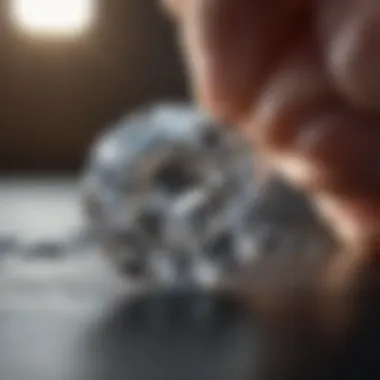
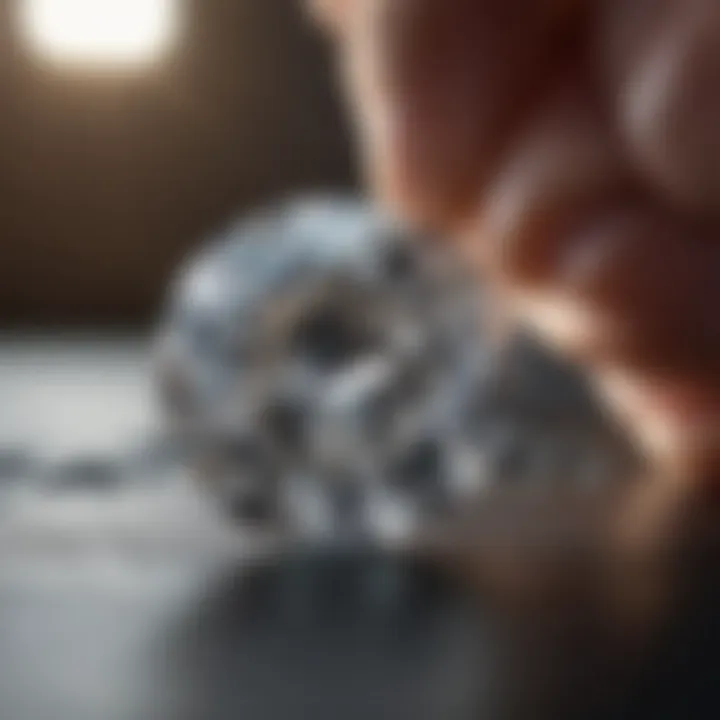
Conflict diamonds, sometimes known as "blood diamonds," are stones mined in war zones and sold to finance armed conflict. This issue has grave implications for communities affected by warfare and violence. The Kimberley Process, established in 2003, aims to prevent the trade of conflict diamonds by requiring certification of diamonds from participating countries.
Diamond cutting companies need to integrate this certification process into their operations. This approach helps ensure that diamonds sourced are conflict-free. The importance of certification is twofold:
- It provides a mechanism for traceability, which reassures consumers.
- It pressures miners and suppliers to adopt ethical practices.
"Consumers today are increasingly aware and concerned about where their diamonds come from."
Engagement with initiatives that promote ethical sourcing can enhance a company's standing in the market and attract a more conscientious consumer base.
Sustainability Practices in the Industry
Sustainability is another critical aspect of ethical considerations in the diamond cutting industry. Companies are now evaluated on their environmental impact and commitment to sustainable practices. This includes:
- Adopting Eco-Friendly Practices: Companies are implementing methods to reduce their carbon footprint during the diamond cutting process. This varies from using water-efficient machines to recycling materials efficiently.
- Fair Labor Practices: Ethical diamond companies ensure fair wages and safe working conditions for employees involved in the diamond cutting process.
- Community Engagement: Companies are also investing in local communities where diamonds are sourced, contributing to social development and improving living conditions.
By embracing sustainability, diamond cutting companies can influence the industry positively, making it more attractive to the new generation of consumers who value ethical commitments.
Consumer Insights and Trends
Understanding consumer insights and trends in the diamond cutting industry is pivotal for both manufacturers and retailers. These insights help guide the creation of products that align with buyer expectations. Moreover, recognizing what consumers prefer can lead to more effective marketing strategies and product designs. Insights about customer behavior can influence the entire supply chain, from sourcing rough diamonds to marketing finished products.
Consumer Preferences in Diamond Cuts
Consumer preferences in diamond cuts vary significantly based on factors such as culture, trends, and individual tastes. Many buyers gravitate toward certain cuts due to their aesthetic appeal and perceived value. For instance, the Brilliant Cut is often favored for its sparkle, making it a popular choice for engagement rings. In contrast, cuts like the Emerald Cut may appeal to those who appreciate antique or vintage styles.
Several factors contribute to these preferences, such as:
- Popularity in Social Media: Platforms like Instagram and Pinterest heavily influence which cuts are trending at any time.
- Cultural Backgrounds: In some cultures, specific cuts signify status or commitment, influencing consumer choices.
- Lifestyle Choices: Buyers often choose cuts that complement their lifestyle. For example, more active individuals may prefer the durability of a Princess Cut.
Market research indicates a clear correlation between emerging styles and consumer buying behavior. Companies must continuously analyze these trends to meet buyer expectations and enhance customer satisfaction.
Purchasing Trends and Patterns
Purchasing trends in the diamond industry reflect broader economic conditions and changes in consumer preferences. One significant trend is the increasing demand for ethically sourced diamonds, especially among millennials and Generation Z. These consumers often prioritize sustainability and ethical considerations over traditional criteria like carat weight or brand prestige.
Key purchasing patterns include:
- Online Shopping: The rise of e-commerce has transformed how consumers buy diamonds. Many prefer researching and purchasing online due to convenience and the ability to compare prices easily.
- Customized Options: There is a marked shift towards personalized jewelry. More customers are seeking bespoke services, wanting unique designs tailored to their preferences.
- Influence of Celebrity Trends: High-profile engagements and celebrity endorsements can significantly sway public interest in certain diamond cuts and styles.
"Understanding purchasing trends is essential for diamond cutting companies to remain competitive and relevant in the industry."
Sales data from various companies confirms that adapting to these trends not only influences sales but also enhances brand loyalty. Companies that react responsively to consumer insights can create lasting connections with their clients, ultimately leading to sustained success in the marketplace.
Future Directions in Diamond Cutting
The diamond cutting industry is undergoing significant transformations as it adapts to new technologies and shifting market dynamics. Understanding these future directions is essential for industry stakeholders, including gemstone enthusiasts, collectors, and jewelry designers. These changes not only influence the quality and precision of diamond cutting but also impact consumer behaviors and ethical considerations within the market.
Emerging Technologies
Technology plays a vital role in shaping the future of diamond cutting. Innovations such as laser cutting and computer-aided design (CAD) are becoming more prevalent. Laser cutting allows for precision that surpasses traditional methods, enabling cutters to achieve intricate designs while minimizing waste. With capable software, CAD enhances the design process, allowing for virtual modeling before actual production begins.
Moreover, advancements in artificial intelligence are starting to make their mark. AI can analyze different cutting techniques and predict the best outcomes based on specific characteristics of the rough diamond. This can lead to increased efficiency in production and improved quality in the final product.
"Emerging technologies revolutionize the diamond cutting industry, promoting not just efficiency but also higher standards in craftsmanship."
As these technologies evolve, it is crucial for cutting firms to stay updated. They must invest in training and equipment to remain competitive in a rapidly changing landscape.
Market Predictions
Predicting the future of the diamond cutting market involves analyzing several factors. First, consumer trends suggest a growing preference for ethically sourced and environmentally friendly stones. Companies that emphasize sustainability are likely to thrive as consumers become more discerning about their purchases.
Second, the popularity of lab-grown diamonds is increasing. As the supply of these stones grows, the diamond cutting industry may need to adjust its strategies. Traditional diamond cutter's techniques will need to incorporate lab-grown stones, as they require different approaches and considerations in handling.
Furthermore, global economic conditions will inevitably impact the industry. Factors such as inflation rates, consumer spending, and trade relations can either boost or hinder market growth.
In summary, the future of diamond cutting is interwoven with technological advancements and evolving consumer preferences. Keeping pace with these trends is crucial for companies aiming to maintain relevancy in the gem industry. Embracing emerging technologies and understanding market shifts will not only benefit cutting companies but also meet the demands of a more informed consumer base.



